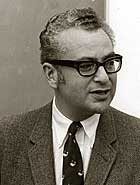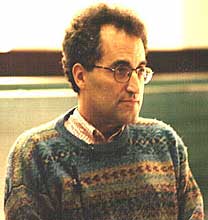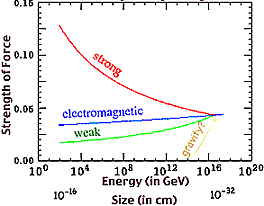To get a perspective on String Theory, consider that our predecessors understood our world less well than does our generation. For example, 200 years ago the best minds on earth had a meager understanding of electricity and not the slightest idea of what we now call radioactivity. That is to say they knew they understood some things poorly and there were other aspects of reality that they did not know existed. This is relevant here because String Theory is a topic that today's best minds understand only meagerly but a topic that portends possibilities of much more reality for which we have not the slightest knowledge. String Theory is still in its infancy. Some don't even consider it yet science because there has been no experimental way to determine if String Theory is correct. It was only a couple months ago that a proposal was made suggesting that it may be possible to determine if there are strings.
You may recall that Albert Einstein spent the latter part of his life trying to unify gravity equations with the equations for the other forces. This notion that all the forces are fundamentally related (i.e., find what things have alike) is a claim by Nature Philosophy that developed partially as a counter view to Newton's very successful analytical method of physics (i.e., take things apart and determine their differences). Over the past couple centuries this effort at unification has inspired a large number of physics discoveries. String Theory is the major current effort to finally COMPLETE unification. Much of the effort has been to establish if Strings can explain what we already know about out universe. (If it can't do that much, it will be of little value for explaining new things.)
Basically String Theory suggests that instead of Euclid's view that space is composed of point locations which can specified by 3 dimensions (or 4 dimensions if you add time as suggested by Einstein), there may be 7 or more additional dimensions which are degenerate or hidden from our normal perceptions. (Think of a thread as having a dimension, length, that is easily perceived from some distance, but other dimensions, such as thickness, which are harder to perceive from that distance.) These degenerate dimensions contain the essential properties of reality. But there is also the possibility that hidden in the degenerate dimensions might be aspects of reality for which we now know nothing. Each string has two properties, mass and tension, governing the vibration of the string.
 To better understand, we should start at the beginning: In 1964 Murray Gell-Mann (1929- , photo left) and George Zweig (1937- ) had proposed that particles like protons and neutrons have substructure that Gell-Mann called quarks. Particles like protons and neutrons would be composed of three quarks while mesons would be composed of a quark and an antiquark. By the early 1970s some scientists were concerned that the existence of isolated quarks might be impossible. The bonding force between a quark and antiquark in a meson could be represented by a 1-dimension string which would have vibrational energy. The string ends would have the properties which describe the quark/antiquark. Any attempt to supply energy to the meson in an effort to break the string making isolated quarks would excite the string vibrations. With sufficient energy, the string would break but the two new ends would simply have quark properties. So instead of isolating lone quarks, there would now be two strings, each a meson with quark/antiquark ends. i.e., the energy invested to break the bond between quark/antiquark would simply create a new quark/antiquark pair! While this early string theory explained why it would be impossible to ever isolate individual quarks, it seemed to have no predictive value as a theory, and it required the supposedly 1-dimension string to have multiple dimensions to quantize all the needed properties. So the early string theory became unpopular with few devoting further effort to develop needed mathematics. By 1974, experimental evidence demonstrated that protons had substructure and quantum chromodynamics (QCD) became the dominant theory for explaining the required strong nuclear force. QCD became part of what gradually became known as the Standard Model explaining all known forces except gravity.
To better understand, we should start at the beginning: In 1964 Murray Gell-Mann (1929- , photo left) and George Zweig (1937- ) had proposed that particles like protons and neutrons have substructure that Gell-Mann called quarks. Particles like protons and neutrons would be composed of three quarks while mesons would be composed of a quark and an antiquark. By the early 1970s some scientists were concerned that the existence of isolated quarks might be impossible. The bonding force between a quark and antiquark in a meson could be represented by a 1-dimension string which would have vibrational energy. The string ends would have the properties which describe the quark/antiquark. Any attempt to supply energy to the meson in an effort to break the string making isolated quarks would excite the string vibrations. With sufficient energy, the string would break but the two new ends would simply have quark properties. So instead of isolating lone quarks, there would now be two strings, each a meson with quark/antiquark ends. i.e., the energy invested to break the bond between quark/antiquark would simply create a new quark/antiquark pair! While this early string theory explained why it would be impossible to ever isolate individual quarks, it seemed to have no predictive value as a theory, and it required the supposedly 1-dimension string to have multiple dimensions to quantize all the needed properties. So the early string theory became unpopular with few devoting further effort to develop needed mathematics. By 1974, experimental evidence demonstrated that protons had substructure and quantum chromodynamics (QCD) became the dominant theory for explaining the required strong nuclear force. QCD became part of what gradually became known as the Standard Model explaining all known forces except gravity.
But the mathematics of strings with additional but hidden dimensions turns out to be useful for Einstein's unsolved problem of finding unifying equations for all forces, what is sometimes called a Theory of Everything. In 1974 Joel Scherk and John Schwarz found that the lowest energy state of a closed loop of string described a massless particle with spin of 2, a match for the mathematics needed to describe the carrier of gravity, the graviton. But such strings could also describe the other known particles with spins of 1, 1/2, and 0. In 1984 Michael Greene and John Schwarz found that anomalies in the mathematics cancelled leaving it free of absurdities. They publicly announced in Aspen that it was possible for the first time to write down a single equation that could explain all the laws of physics, all the forces of nature, the theory of everything. As a result, the number of scientists interested in string theory increased from three to roughly 500. It was realized that the mathematics of strings theory could describe what previously seemed contradictory: the Standard Model of small scale quantum physics and the large scale gravity of General Relativity.
Out of that excitement, five distinct string theories developed. It was realized that the mathematics could describe objects extended in more than one dimension such as two dimensional membranes. Paul Townsend coined the term p-brane to describe objects extending in p
dimensions. All but one of the string theories contained closed loops of vibrating strings. In 1987, David Gross, Jeffrey Harvey, Emil Martinec, and Ryan M. Rohm, known as the Princeton string quartet, discovered that one of the string theories involving supersymmetry could provide an explanation for dark matter.
 In 1994, Edward Witten (photo at left) proposed that the five superstring theories, plus a sixth found later that exists in eleven dimensions, are manifestations of an underlying M-theory that ties them all together. In M-theory, the universe has 11 dimensions, 10 of space and one of time, and it consists not just of strings but also multiple-dimensional branes. Strings which are not closed loops might terminate on branes. Each string vibrates in a mode that determines which particle it is. So one mode of vibration is a graviton while another mode of vibration is a photon. If all the particles are related, then additional particles and decays should exist, some of which should be detectable in the next generations of particle accelerators.
In 1994, Edward Witten (photo at left) proposed that the five superstring theories, plus a sixth found later that exists in eleven dimensions, are manifestations of an underlying M-theory that ties them all together. In M-theory, the universe has 11 dimensions, 10 of space and one of time, and it consists not just of strings but also multiple-dimensional branes. Strings which are not closed loops might terminate on branes. Each string vibrates in a mode that determines which particle it is. So one mode of vibration is a graviton while another mode of vibration is a photon. If all the particles are related, then additional particles and decays should exist, some of which should be detectable in the next generations of particle accelerators.
For the present, String Theory is popular because the powerful mathematics can describe all the forces and all the kinds of objects in the universe. Because each string might be amazingly small, 10-30cm, direct confirmation could be impossible. But theorists hope that evidence left from when the universe was much smaller, shortly after the Big Bang, will eventually give evidence that String Theory is correct. Strings may even contain information that survived from before the Big Bang. For now, this is entirely speculation. A great deal of the thinking about String Theory is done using the language of mathematics. So to learn much more about Strings, one needs to master the tools of mathematics.
 It is probably clear that there are as yet no physical experiments that we can do to help understand String Theory. Those working on String Theory are developing the relevant mathematics, investigating the implications of the theory, and even attempting to visualize strings using computer graphics (note the icon used for this section is from such an effort by Julius Kuti.)
It is probably clear that there are as yet no physical experiments that we can do to help understand String Theory. Those working on String Theory are developing the relevant mathematics, investigating the implications of the theory, and even attempting to visualize strings using computer graphics (note the icon used for this section is from such an effort by Julius Kuti.)
 Size is sometimes a confusing property. Consider the following examples:
Size is sometimes a confusing property. Consider the following examples:
 An electron has no detectable internal structure so is often regarded as a point in space. Yet the uncertainty principle suggests that an electron in a hydrogen atom may be found anywhere in a volume of diameter of the atom. So should an electron be said to be the size of the electron
An electron has no detectable internal structure so is often regarded as a point in space. Yet the uncertainty principle suggests that an electron in a hydrogen atom may be found anywhere in a volume of diameter of the atom. So should an electron be said to be the size of the electron cloud(10-10 m), or much smaller?
Communicating technical information such as observations and findings is a skill used by scientists but useful for most others. If you need course credit, use your observations in your journal to construct a formal report.
Physicists have found mathematical evidence that some of string theory's predictions match closely with those of gauge theory, which explains the interactions among quarks and gluons, the fundamental particles which compose protons, neutrons and more exotic subatomic particles. The discovery could be used for string theory to tackle physics problems such as interactions among the quarks within atomic nuclei. Igor Klebanov at Princeton described, We have previously been able to study these interactions in detail only at the high-energy conditions within particle accelerators, but with these findings we may be able to describe what's happening inside the atoms that make up rocks and trees. We cannot do so yet, but it appears that the math of string theory could be what we need to bridge this gap.
Gauge theory provides a well-established, coherent picture of the behaviors of quarks and gluons at very high energies observed over decades when two particles are smashed together inside particle accelerators. At these high energies, the force holding the quarks together is overcome allowing particles to break apart. When the quarks and gluons again bind together into protons and neutrons, this interaction force grows very strong. At the lower energies it is hard to use gauge theory to understand the interaction.
In the 1970s, physicists suggested that when gauge theory loses its power to describe particle behavior as quarks bond together, string theory might be able provide understanding. a breakthrough came in 1997 and early 1998 when a precise relation between the two was conjectured in the work of Princeton physicists Alexander Polyakov, Steven Gubser and Klebanov, as well as the Institute for Advanced Study's Juan Maldacena and Edward Witten. However, more work was needed to verify this connection. Klebanov had little more than a hunch that there was any smooth transition between gauge and string theory.
Niklas Beisert at Princeton published a paper in late October 2006 containing an equation that turned out to be a crucial piece of the puzzle. Beisert and his collaborators made a guess based on gauge theory behavior. Their equation provided the 'transition' between weak and strong interaction strength. They demonstrated that it exactly matched string theory's predictions at the strong interaction limit. The mathematical match verifies that string theory and well-established gauge theory are indeed two sides of the same coin.
That a particular kind of gauge theory is in a sense exactly solvable realizes a long-standing dream. Still, the string theory won't yet become the overall explanation of subatomic physics. This is only one step toward solid experimental proof that the world is actually constructed of tiny vibrating strings. This applies to only one facet of gauge theory. But it provides hope that other facets of gauge theory are amenable to similar treatment.
Abstract: A Test of the AdS/CFT Correspondence Using High-Spin Operators
M. K. Benna, S. Benvenuti, I. R. Klebanov, A. Scardicchio
In two papers the planar perturbative expansion was proposed for the universal function of the coupling appearing in the dimensions of high-spin operators of the [script N]=4 super Yang-Mills theory. We study numerically the integral equation derived by Beisert, Eden, and Staudacher, which resums the perturbative series. In a confirmation of the anti-de Sitter-space/conformal-field-theory (AdS/CFT) correspondence, we find a smooth function whose two leading terms at strong coupling match the results obtained for the semiclassical folded string spinning in AdS5. We also make a numerical prediction for the third term in the strong coupling series.